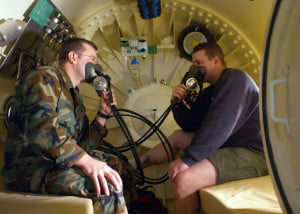
By: Paul G. Harch, Susan R. Andrews, Edward F. Fogarty, Daniel Amen, John C. Pezzullo, Juliette Lucarini, Claire Aubrey, Derek V. Taylor, Paul K. Staab, and Keith W. Van Meter
Abstract
This is a preliminary report on the safety and efficacy of 1.5 ATA hyperbaric oxygen therapy (HBOT) in military subjects with chronic blast-induced mild to moderate traumatic brain injury (TBI)/post-concussion syndrome (PCS) and post-traumatic stress disorder (PTSD). Sixteen military subjects received 40 1.5 ATA/60 min HBOT sessions in 30 days. Symptoms, physical and neurological exams, SPECT brain imaging, and neuropsychological and psychological testing were completed before and within 1 week after treatment. Subjects experienced reversible middle ear barotrauma (5), transient deterioration in symptoms (4), and reversible bronchospasm (1); one subject withdrew. Post-treatment testing demonstrated significant improvement in: symptoms, neurological exam, full-scale IQ ( + 14.8 points; p < 0.001), WMS IV Delayed Memory ( p = 0.026), WMS-IV Working Memory ( p = 0.003), Stroop Test ( p < 0.001), TOVA Impulsivity ( p = 0.041), TOVA Variability ( p = 0.045), Grooved Pegboard ( p = 0.028), PCS symptoms (Rivermead PCSQ: p = 0.0002), PTSD symptoms (PCL-M: p < 0.001), depression (PHQ-9: p < 0.001), anxiety (GAD-7: p = 0.007), quality of life (MPQoL: p = 0.003), and self-report of percent of normal ( p < 0.001), SPECT coefficient of variation in all white matter and some gray matter ROIs after the first HBOT, and in half of white matter ROIs after 40 HBOT sessions, and SPECT statistical parametric mapping analysis (diffuse improvements in regional cerebral blood flow after 1 and 40 HBOT sessions). Forty 1.5 ATA HBOT sessions in 1 month was safe in a military cohort with chronic blast-induced PCS and PTSD. Significant improvements occurred in symptoms, abnormal physical exam findings, cognitive testing, and quality-of-life measurements, with concomitant significant improvements in SPECT.
___
Hyperbaric Chambers for sale on eBay
___
Keywords: hyperbaric oxygen therapy; post-concussion syndrome; post-traumatic stress disorder; single photon emission computed tomography; traumatic brain injury
Click here for the full report
Layperson Summary
A Phase I study conducted by Paul G. Harch and colleagues explores the safety and effectiveness of 1.5 ATA hyperbaric oxygen therapy (HBOT) in military subjects suffering from chronic blast-induced mild to moderate traumatic brain injury (TBI)/post-concussion syndrome (PCS) and post-traumatic stress disorder (PTSD). Sixteen military subjects underwent 40 HBOT sessions over 30 days. Various assessments, including symptoms, physical and neurological exams, brain imaging, and psychological testing, were conducted before and after treatment.
The study found that the subjects experienced some reversible side effects such as middle ear barotrauma, transient symptom deterioration, and bronchospasm. However, post-treatment testing revealed significant improvements in several aspects, including symptoms, neurological exam results, cognitive functioning, PTSD and depression symptoms, quality of life, and self-reported improvements. SPECT brain imaging also showed positive changes, such as improvements in regional cerebral blood flow, particularly in white matter regions, following 1 and 40 HBOT sessions. The study suggests that 1.5 ATA HBOT sessions in a military cohort with chronic blast-induced PCS and PTSD can be safe and associated with significant improvements in various measures.